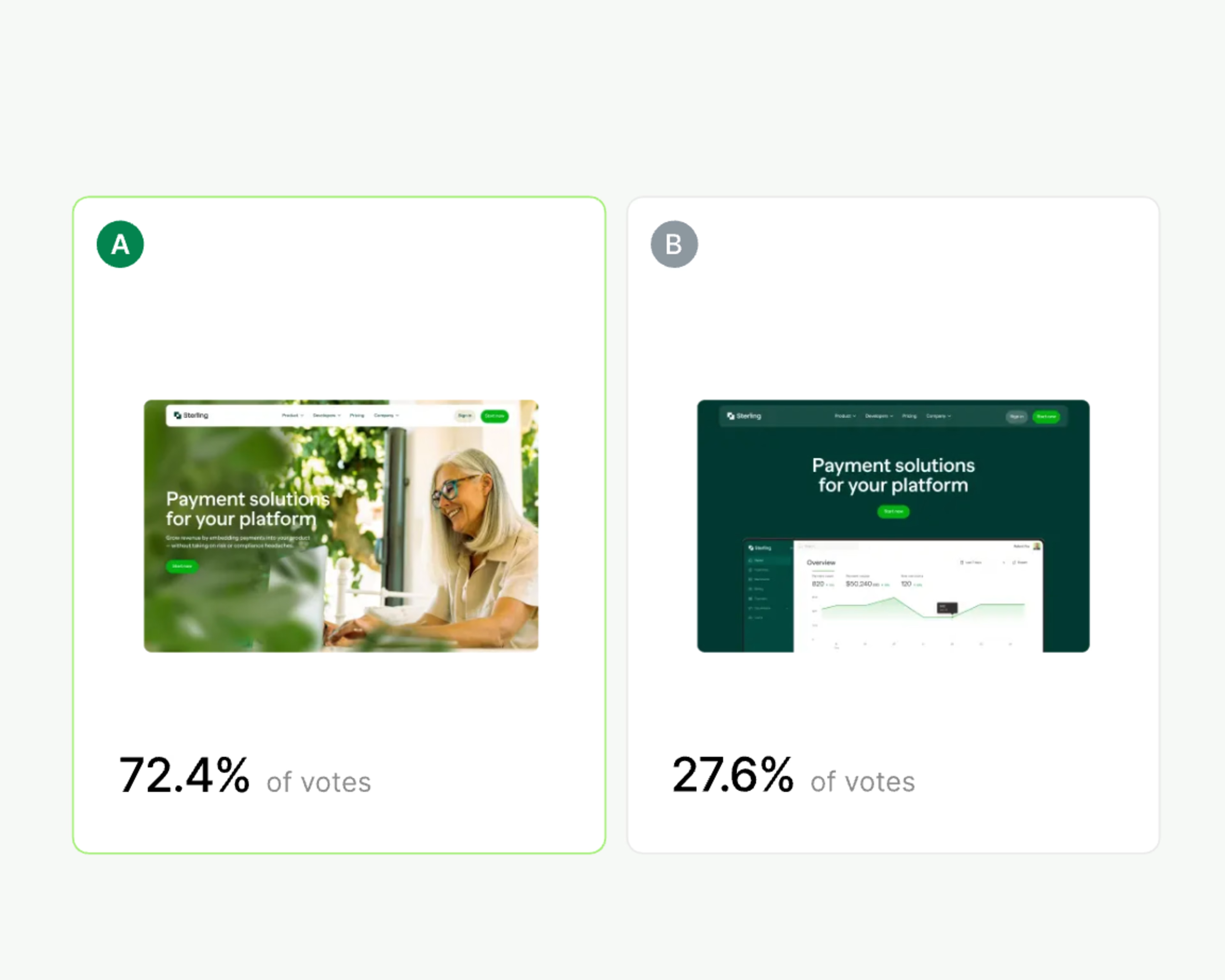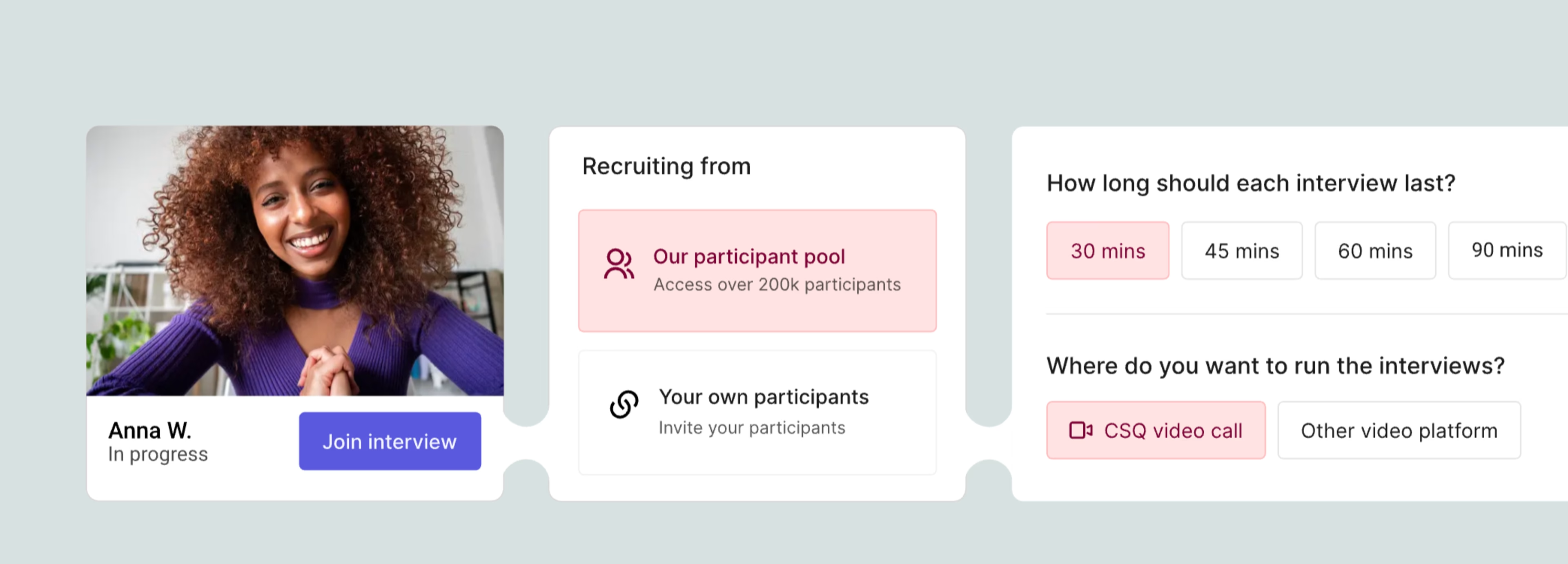User interviews are a valuable way to get real data that improves your product, service, or customer experience. But you can’t just show up to a customer call and hope for the best: to get the most out of your user interviews, you need to ask the right questions.
Whether you’re undertaking user research, developing a new product, or looking to improve your user experience (UX) design, the perfect user interview question can unlock a whole host of insights and lead to actionable improvements for your business.
Read on to discover:
Examples of user interview questions (and when to use them)
How to come up with actionable and empathetic user interview questions
Examples of user interview questions (and when to use them)
The opportunities for user interviews are almost endless. After all, what aspect of your business can’t be improved with insights from your target market?
When done right, user interviews are solution-focused, customer-centric, and empathetic, making them an ideal user research method for anyone who wants to stay close to their customers. But in order to get actionable data, it’s crucial to have a specific goal in mind for each interview.
💡 Pro tip: already using Contentsquare? You're probably familiar with Heatmaps, Session Replay, and Surveys, but did you know you can connect with your users on an even deeper level with user interviews?
Contentsquare Interviews lets you easily schedule, run, and analyze user interviews, giving you another level of comprehensive insights that empower you to make customer-centric decisions.
Here are just a few examples of scenarios and use cases where user interviews shine, and some research questions to ask for each one.
Concept testing
What it is: concept testing is a method of evaluating early-stage product, service, campaign, or project ideas to understand whether a concept is viable and what improvements you should make. It involves showing a prototype (or prototypes) of your concept to interview participants and gathering feedback.
How user interviews help, and when to use them: concept testing happens early in the development process. The goal is to get valuable feedback before investing significant resources, then use this feedback to validate assumptions and nail down your direction. For example, if you’re undergoing a rebrand, you could show participants three versions of your new logo and branding and ask them which concept they prefer.
User interview questions to ask for concept testing:
What’s your first reaction to this prototype?
What do you like and dislike about this prototype?
How would you improve this design?
Based on this prototype, who do you think the target audience for this product/service/brand is?
Need an idea validated ASAP? Start with a quick concept testing survey to gather immediate feedback from a wide range of users. Then, once you’ve gathered initial feedback on your concepts, schedule user interviews to get more detailed insights and understand why they do or don’t resonate.
Market research
What it is: market research is the process of gathering and analyzing information to help you better understand your target market.
How user interviews help, and when to use them: market research is especially crucial when launching a new business or offering (such as a new product, feature, or service). However, it can be done at any time to ensure you consistently meet your target audience’s ever-evolving needs.
User interview questions to ask for market research:
What department are you in?
What are the top challenges your team/company is facing right now?
What products are you currently using to solve those challenges?
Which features are most important to you in a product like this?
Did you know that Contentsquare has a survey template for this exact goal?
💡Use our market research survey template to kick-start your user interview process and gather a range of feedback from a specific cohort. Once you’ve analyzed your results, follow up with specific users to dig deeper into their responses with one-to-one user interviews.
![[Visual] Examples of open-ended surveys, Market research](http://images.ctfassets.net/gwbpo1m641r7/1j7qjlKpDW37c6H4K8tApU/164629ceeec45a4ccc2fa026bcf57bdf/Screenshot_2024-11-04_at_19.36.31.png?w=3840&q=100&fit=fill&fm=avif)
Use our survey template to get valuable initial feedback for your market research—or borrow the questions to use in one-to-one user interviews
Product development
What it is: product development is the process of, well, developing a new product. This can be a digital product, such as those created by software-as-a-service (SaaS) businesses, or a physical product, like a new flavor of cat food.
How user interviews help, and when to use them: once you’ve done your market research and concept testing and you’re in the product development phase, continue to conduct user interviews to stay on the right track. Product development user interviews are typically done pre-launch, while the product is still in beta, but they’re also useful post-launch and as part of a continuous improvement strategy.
User interview questions to ask for product development:
What do you like and dislike about this product?
Does this product have the features you need? Is there any additional functionality you need?
How do you feel this product compares to similar products on the market?
On a scale of 1–10, how likely are you to buy this product?
Is there anything that would prevent you from buying or using this product, and if so, what?
⚡ There’s a Contentsquare survey template for this goal, too!
Take inspiration from our product feedback survey, feature prioritization survey, and product market fit survey templates. Pick and mix from the suggested questions to build your own bank of questions for your product development user interviews.
You can even use the beta feedback survey to recruit new beta users for upcoming feature or product launches, then arrange user interviews in Contentsquare to follow up and gather more detailed feedback.

Use Contentsquare to get beta testers for new features or products, then follow up with in-depth user interviews to get more detailed product development insights
Usability testing
What it is: usability testing is a method of testing the functionality of a website, app, or other product by observing how easy (or difficult) it is for users to complete tasks.
How user interviews help, and when to use them: it’s helpful to run usability tests before launching a new feature or product, but they’re just as vital if your session recordings or heatmaps surface issues that could be attributed to poor usability or UX. These include a sudden drop-off in conversions or a lot of rage clicks (i.e. repeated clicks in specific areas or on certain elements that usually indicate user frustration).
User interview questions to ask for usability testing:
How did you complete this action? Please talk us through the specific steps you took.
On a scale of 1–10, how easy was it for you to complete this specific set task?
Can you tell me why you did X/took Y approach?
Did you find all the information you needed?
Contentsquare lets you combine session recordings and heatmaps insights with user interviews to get both quantitative and qualitative data for your usability tests.
Use Session Replay to see exactly what (anonymized) users see and do on your site, including where they encounter bugs or get frustrated. Filter your recordings to quickly identify broken elements, investigate drop-off activity, or compare variants in an A/B test.
You can also use heatmaps to identify areas of engagement, rage clicks, or content that gets overlooked.
With these insights in mind, run targeted user interviews to hear your users’ thought processes and direct feedback—allowing you to understand not only what they did on your site, but why they did things that way.
Customer satisfaction
What it is: customer satisfaction describes how happy people are with a company’s products, services, and overall customer experience.
How user interviews help, and when to use them: customer satisfaction is often measured using a customer satisfaction (CSAT) survey or a Net Promoter Score® (NPS®) survey. This feedback should be gathered throughout the customer journey for a continuous pulse on different aspects of the user experience. For example, it’s common to send a CSAT survey after a user reaches out to a support team or makes a purchase, so companies can gauge how successful those experiences were.
If a customer gives a particularly high or a particularly low rating, or leaves an interesting piece of feedback, it may be worth scheduling a user interview with them to find out more. This helps you understand what you’re doing right and where you can improve—and enables you to fix any problematic elements before they result in churn.
User interview questions to ask for customer satisfaction:
On a scale of 1–10, how likely are you to recommend us to a friend or colleague? Why did you give that rating?
Can you tell me about your recent experience with our support team?
How does the service you received compare to the service you’ve received from other brands?
What would make your experience better?
Churn analysis
What it is: churn analysis is the process of measuring and understanding the reasons why customers stop doing business with your company (also known as customer churn).
How user interviews help, and when to use them: consider asking customers who have churned to do a user interview so you can learn more about their reasons for canceling. However, remember that since they’re no longer customers, you may need to offer an incentive for them to give feedback.
User interview questions to ask for churn analysis:
What were your main reasons for churning?
Would you consider using our product/service again in the future? Why or why not?
If you churned to go to a competitor, can you tell me which one, and why you decided to use them instead?
Contentsquare’s exit-intent survey lets you get feedback from users at the moment they’re leaving, which is crucial to understanding how you can improve your offering and reduce churn.
After analyzing exit-intent survey results, identify key churn reasons and address them to make sure your product or service is more tailored to customer needs.
How to come up with actionable and empathetic user interview questions
While having specific questions in mind is a great start, how do you craft (and ask) your own user interview questions that are human, empathetic, and customer-focused? Follow these best practices.
1. Have a clear goal upfront
One of our best tips for mastering user interviews? Work backward from what you’re trying to achieve.
For example, if you’re building a new feature aimed at product managers who work in startups, you’ll want to understand their typical workflow, which metrics they’re responsible for, and what sort of product design appeals to them. To gather this information, you could source interview participants from your target demographic and build a list of questions to help you uncover these insights.
Don’t ask this: What do you want from a tool?
Ask this instead: What does your current workflow for this process look like, and what tools do you use for it?
Contentsquare Interviews lets you focus on the interview, instead of the admin
By using one platform to seamlessly recruit, schedule, host, and record your user interviews, you avoid the hassle of organizing and managing your user interviews—allowing you to spend your time developing thoughtful questions, not sending out invites.
2. Use evidence to understand the user journey and pain points
Don’t start in the dark. Identify trends and get evidence from user behavior analysis tools like recordings, heatmaps, surveys, and feedback to inform your approach.
Then, use interviews as an opportunity to add richness, validate assumptions, and get qualitative insights that expand your quantitative data. This helps you be more empathetic and customer-centric when developing and asking your user interview questions, because you’re basing them on real customer experiences and feedback.
Don’t ask this: Would you do X or Y?
Ask this instead: I noticed that you did X. Could you tell me why you took that approach?
3. Make your questions and the interview process as inclusive as possible
For the best insights, you should aim to get a broad range of perspectives from multiple viewpoints. This means selecting the right interviewees and curating a diverse panel. But it also means asking the right questions—and in the right way—to ensure you create an inclusive interview environment that’s mindful of different factors and how they affect our experiences, such as cultural differences, gender, neurodiversity, and age.
Creating an inclusive interview environment helps all participants feel more comfortable and confident to give honest, genuine feedback.
Don’t ask this: Do you prefer the feedback widget as a modal or as a full-page popover?
Ask this instead: When it comes to leaving feedback, do you have a preference between these two options? Here’s option A, and here’s option B.
Here are three more ways you can make your interview process supportive and inclusive:
Use simple language. English isn’t everyone’s first language—and even if it is, people may not be familiar with your industry’s terminology. Avoid unnecessarily complicated words and give interviewees time to process (and translate) their answers.
Share an outline in advance. Consider sharing a broad outline of what you will discuss in the interview before the day so participants know what to expect and can prepare beforehand.
Provide an opportunity to follow up. Sometimes your best insights come after the conversation has ended and you’ve had time to reflect. Share a contact address or send a follow-up survey to your interviewees to capture any additional thoughts.
Use Contentsquare to find the right interview participants
Contentsquare Interviews ensures you get the right audience for your user interviews by drawing on our diverse pool of 200,000+ participants from all over the world. Reach participants from over 130 countries and 25 industries, or invite your own users to take part.

Use pre-interview screening to find the right match from Contentsquare’s pool of over 200,000 participants
4. Ask open-ended questions, not leading questions
You know what a leading question is, right?
…That was a leading question. Leading questions are those that are phrased or presented in a certain way to try and elicit a specific answer. (In this example, presenting it in a way that assumed you knew what a leading question was may have made you less confident to say, “Actually, I don’t know.”)
Leading questions cause problems in user research interviews because they can skew data by telling you what you want to hear, not what you need to hear.
Instead, use a combination of open- and closed-ended questions to give interviewees opportunities to provide more information above and beyond what you expect (or hope) to hear.
Don’t ask this: How much do you love our product?
Ask this instead: Would you recommend our product to a friend or colleague? Why or why not?
5. Leave room for follow-up questions
One of the greatest benefits of user interviews is that they unearth new insights you didn’t even know to consider when you were plotting out your interview script.
So don’t be afraid to ask follow-up questions to help you dig into new information. Even with the most comprehensive, planned-out questions, you won’t be able to think of absolutely everything in advance, so leave a little room for this semi-structured approach.
As long as you keep the overall research goals of your user interview in mind, it’s perfectly okay to take a few extra minutes to ask an unscripted question.
Don’t ask this: Wow, that’s a really interesting point! Anyway, can you answer my next question?
Ask this instead: Wow, that’s a really interesting point! Can you tell me a little bit more about that?
Contentsquare Interviews takes care of the notetaking for you
Good notes are essential—but taking them can be time-consuming and pull you out of the flow of the interview.
Instead of requiring additional resources to take notes, Interviews automatically records and transcribes your user interviews, so you have a complete, time-stamped transcript at the end. This makes it easy to go back and analyze or share valuable insights, while also ensuring you can stay present and in the moment while interviewing.
Unlock valuable insights by asking the right user interview questions
From UX research to qualitative research and beyond, user interviews help you understand your customers’ needs and preferences. Whether you use these example questions or create your own, use these tips to ask better questions—and get better insights.
User interview questions FAQs
Before any user interview, you should know the goals of your research and what questions you’re ultimately trying to answer for your business. With that in mind, create a targeted list of questions to ask participants—but leave a little room to go off-script if necessary.
